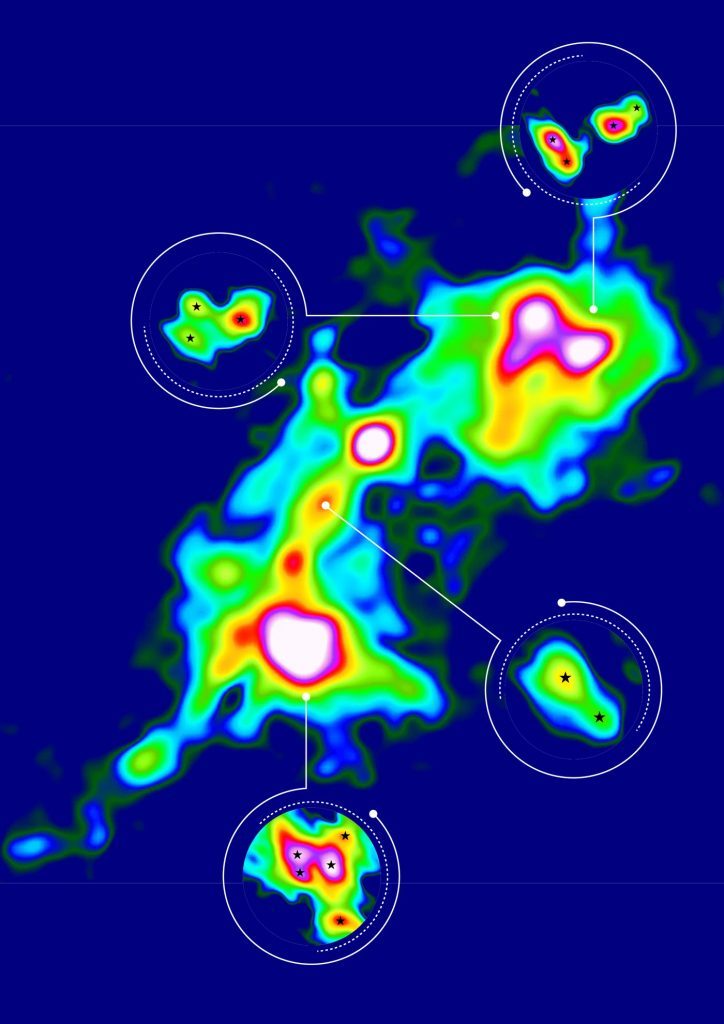New observations confirm computer models how massive stars are born as multiples
Astrophysicists have predicted the multiplicity of massive star births for a long time. But so far, there was little observational evidence confirmation for it. A detailed study led by researchers of the Max Planck Institute for Astronomy in Heidelberg now found four binary proto-stars, one triple, one quadruple and one quintuple system in one massive star cluster. The new results were in agreement with models developed by HITS researcher Rajika Kuruwita and confirm our current understanding of the formation of massive stars: such stars are indeed born as multiples.

© S. Li, MPIA / J. Neidel, MPIA Graphics Department / Data: ALMA Observatory
For massive stars, multiple birth has long thought to be the norm, shown by computer simulations which traced the collapse of giant clouds of gas and dust from the beginnings to the formation of separate stars within: a hierarchical process in which larger cloud portions contract to form denser cores, and where smaller regions within those “parent cores” collapse to form the separate stars: massive stars, but also numerous less massive stars.
Until now, however, key evidence was missing because it is very difficult to observe star formation regions in sufficient detail. This became possible once the ALMA observatory in Chile became operational. An international group of researchers used this opportunity to observe 30 promising massive star-formation regions with ALMA.
The analysis was led by Shanghuo Li (Max Planck Institute for Astronomy, Heidelberg, Germany), and the results have now been published in Nature Astronomy. They found four binary proto-stars, one triple, one quadruple and one quintuple system – consistent with the expectations. HITS researcher Rajika Kuruwita contributed to this work by providing some computer models that were tested against the observation. “We found that the observed separation distribution between the stars in these young multiple-star systems is in agreement with our models of multiple-star systems forming via core fragmentation.”
For detailed information on the study, see the MPIA press release: https://www.mpia.de/news/science/2024-02-multiplicity-starformation
Publication:
Shanghuo Li et al., “Observations of high-order multiplicity in a high-mass stellar protocluster,” Nature Astronomy. 15 January 2024. https://www.nature.com/articles/s41550-023-02181-9
Publication on the computer models developed by Rajika Kuruwita: The contribution of binary star formation via core fragmentation on protostellar multiplicity
A&A, Volume 674, June 2023. https://www.aanda.org/articles/aa/abs/2023/06/aa44882-22/aa44882-22.html
About HITS
HITS, the Heidelberg Institute for Theoretical Studies, was established in 2010 by physicist and SAP co-founder Klaus Tschira (1940-2015) and the Klaus Tschira Foundation as a private, non-profit research institute. HITS conducts basic research in the natural, mathematical, and computer sciences. Major research directions include complex simulations across scales, making sense of data, and enabling science via computational research. Application areas range from molecular biology to astrophysics. An essential characteristic of the Institute is interdisciplinarity, implemented in numerous cross-group and cross-disciplinary projects. The base funding of HITS is provided by the Klaus Tschira Foundation.